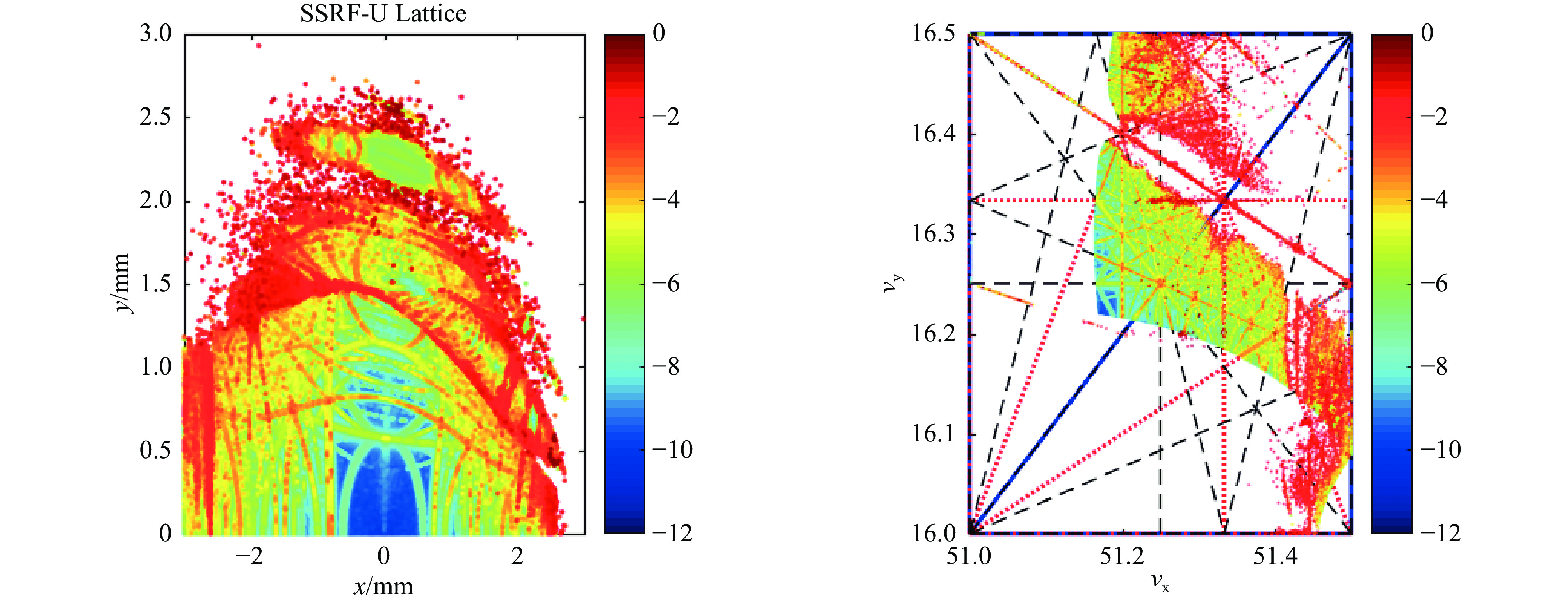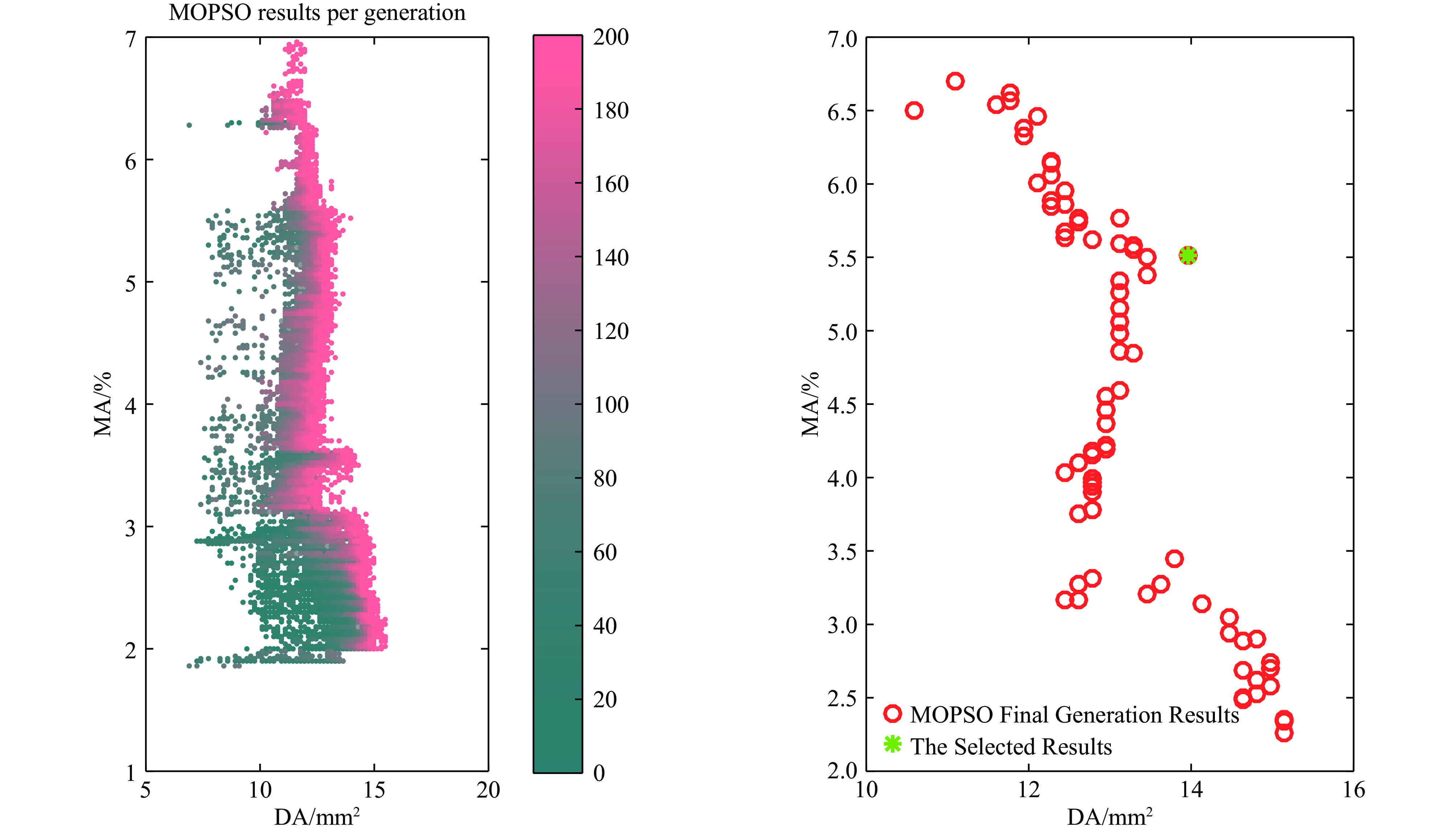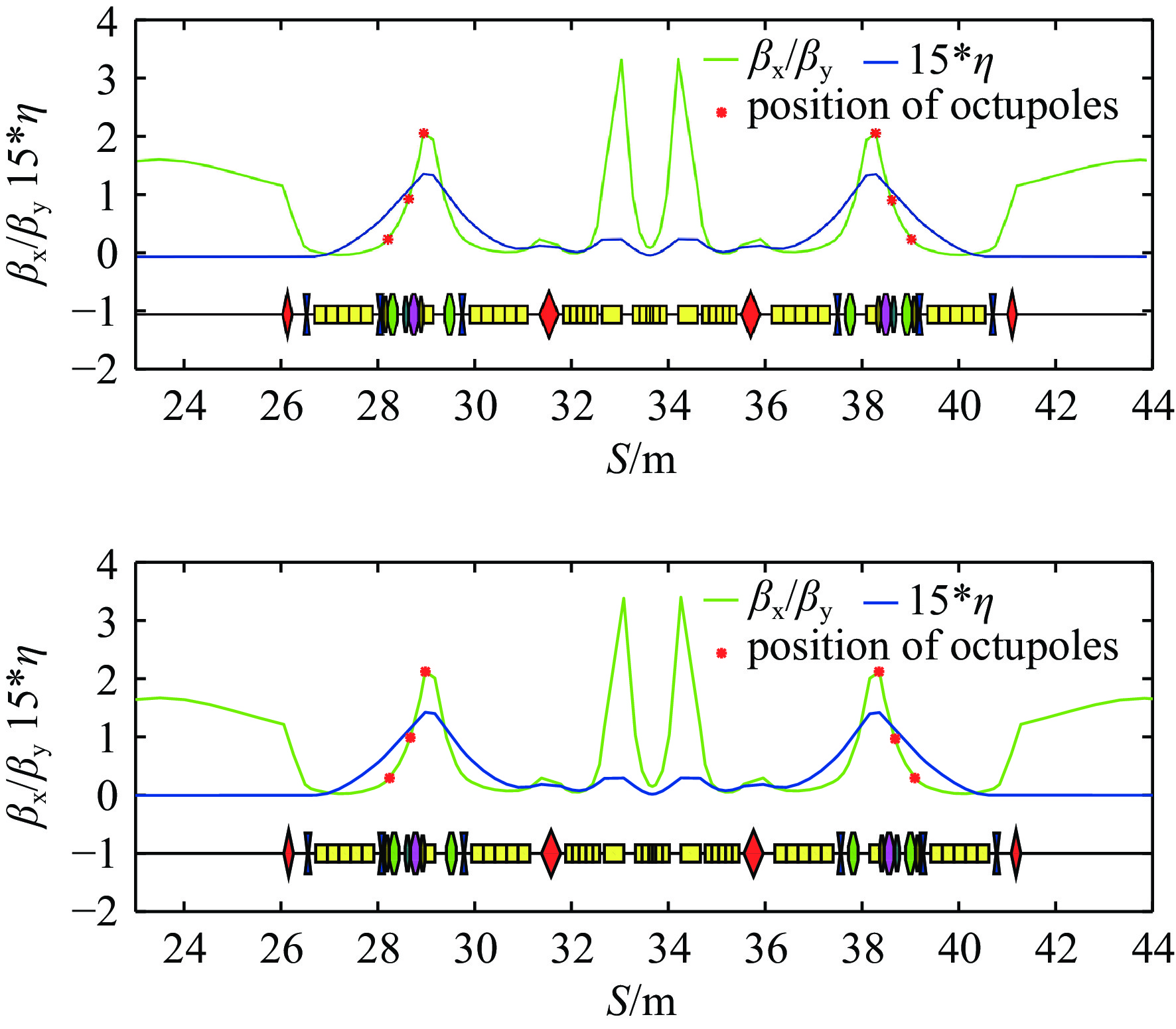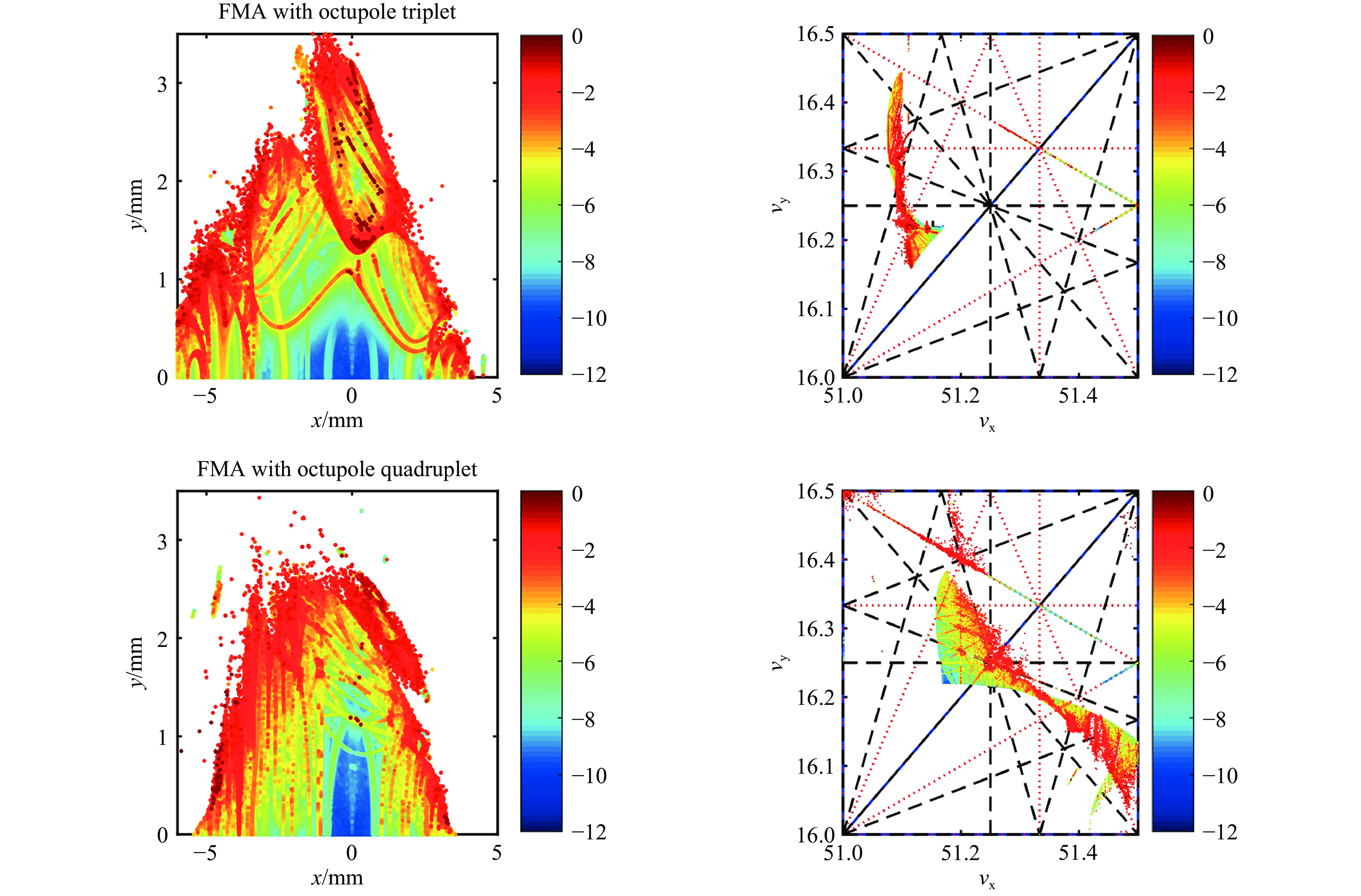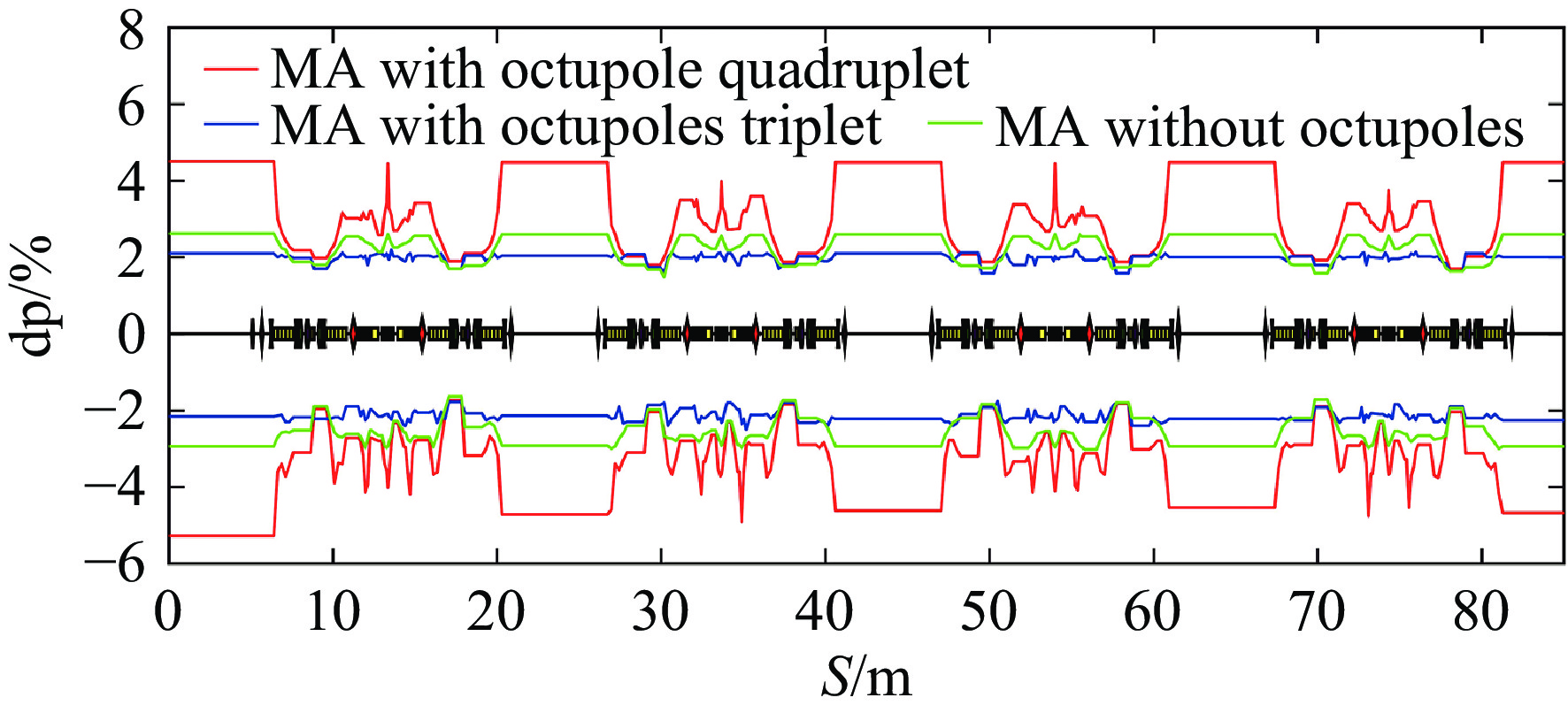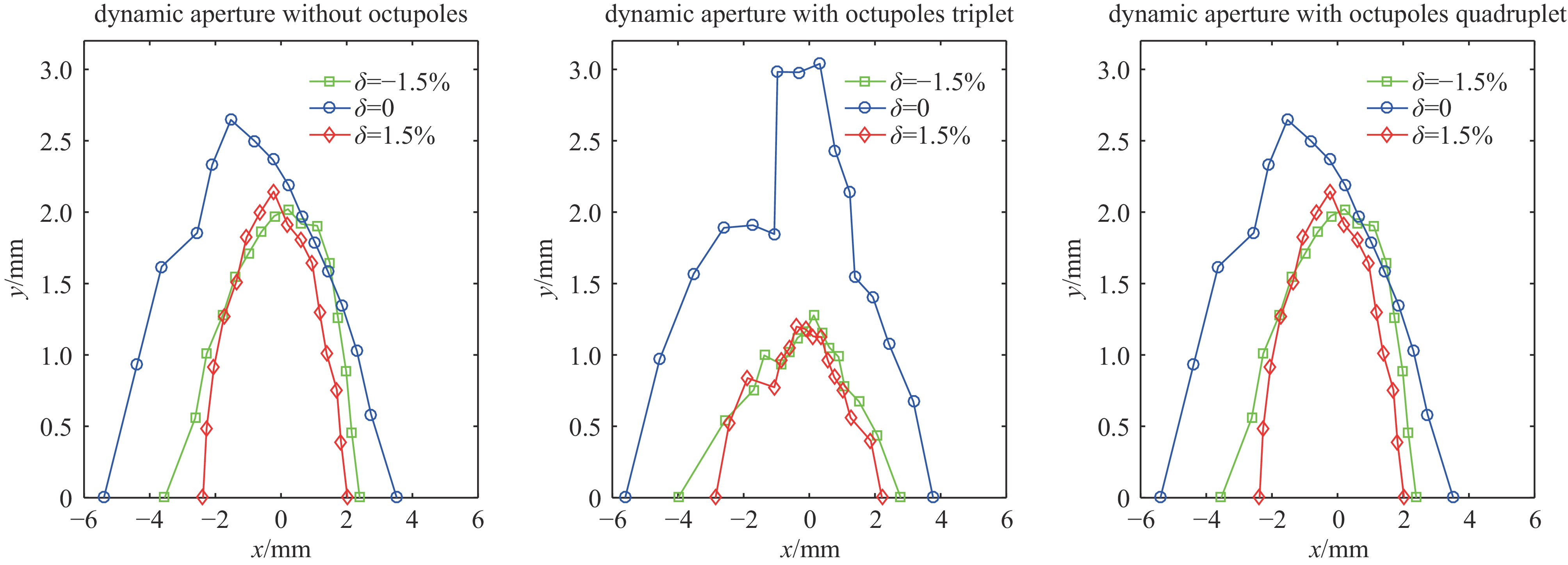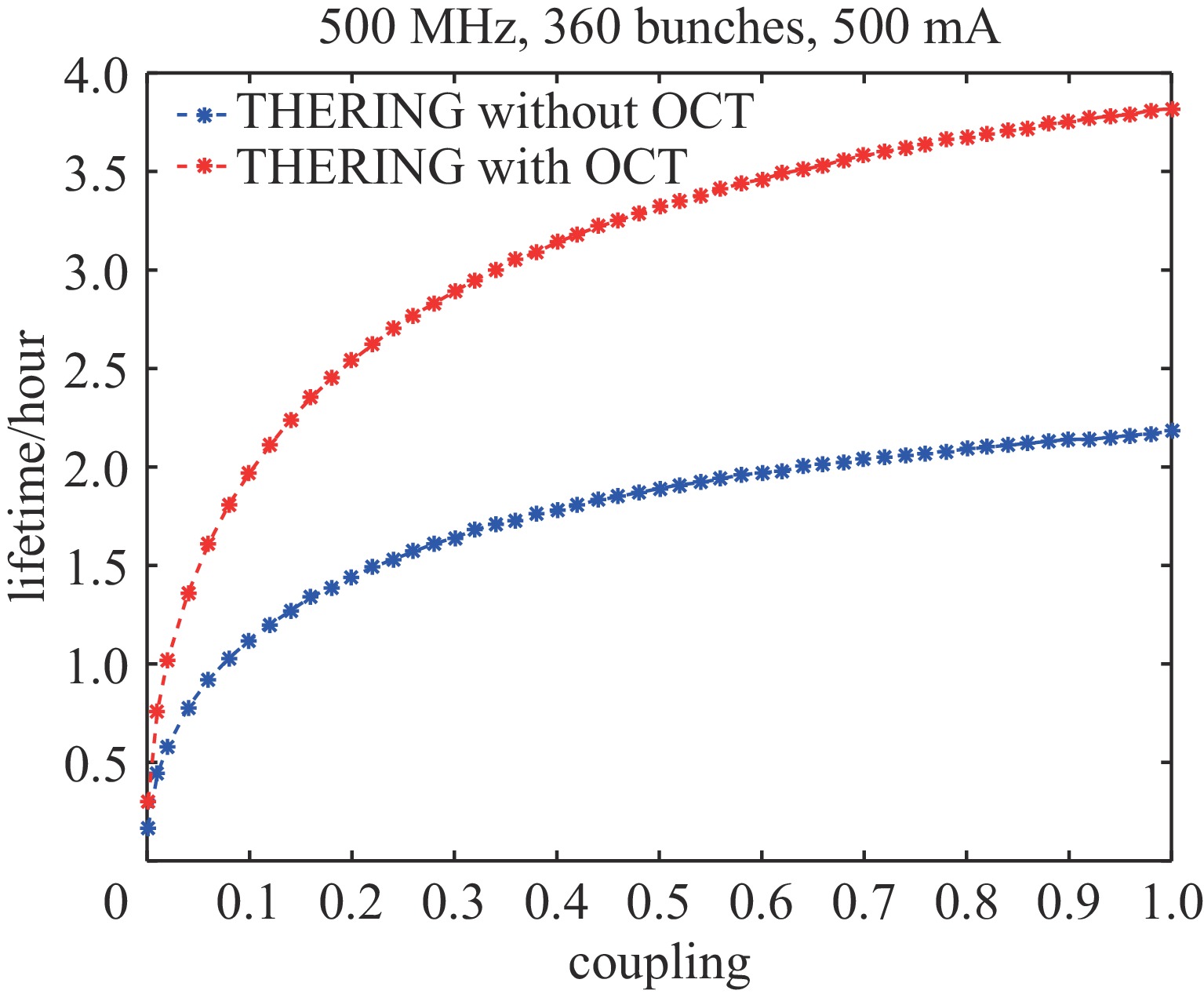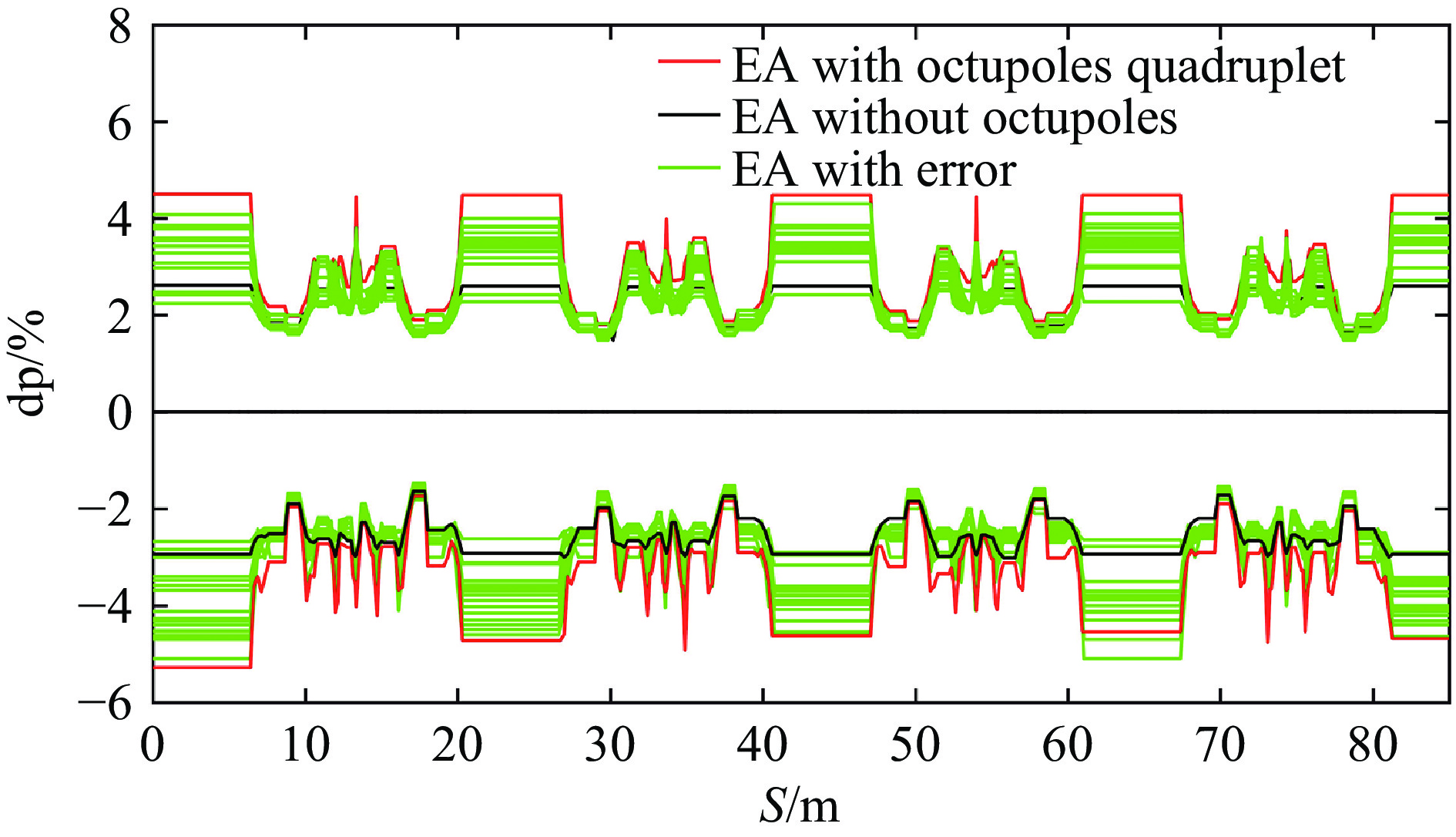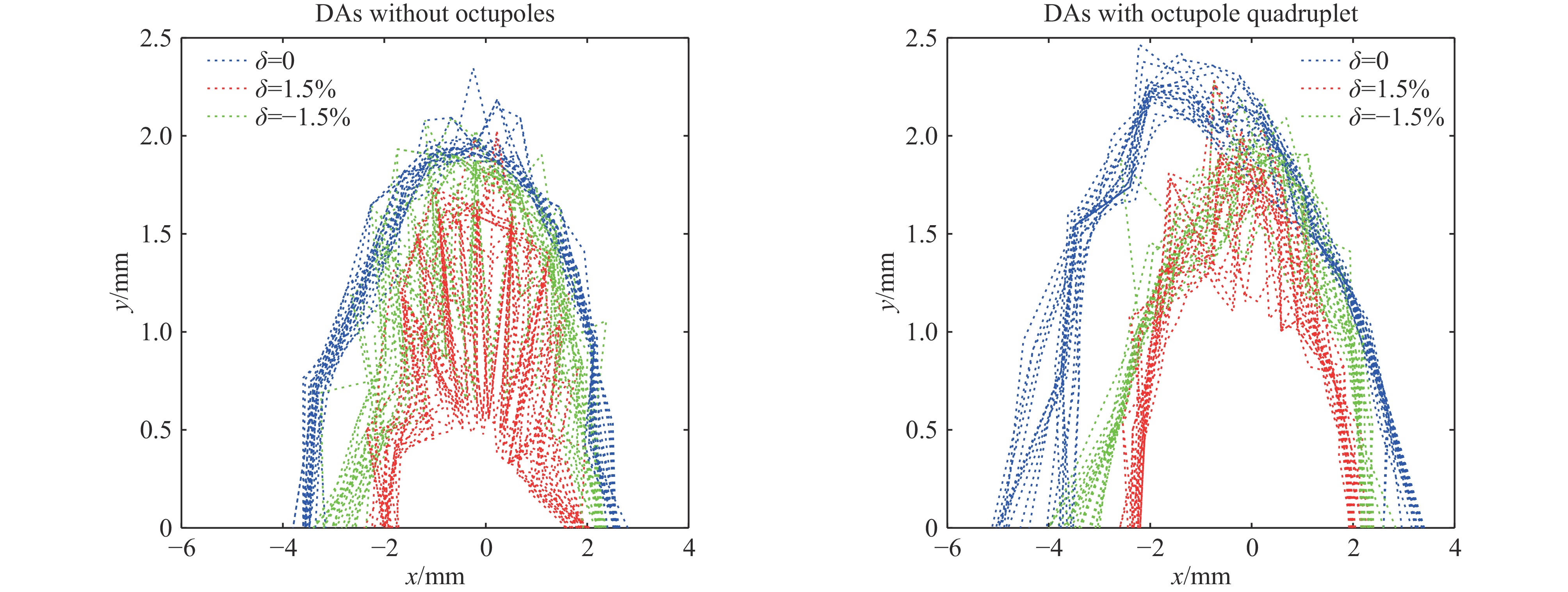-
摘要: 新一代光源具有极低发射度,产生更高亮度的同步辐射光,探索更小物质尺度。低发射度会使得四级铁强度提高,产生较高的自然色品,需要六极铁校正这些自然色品。为了达到衍射极限环要求,为上海同步辐射光源升级改造(SSRF-U)设计新磁聚焦结构,在3.5 GeV束流能量下实现了72.2 pm·rad的自然发射度。然而,由于六极铁强度高,产生高度二阶共振驱动项会引起失谐效应,降低储存环性能。为了解决这个问题,计划在SSRF-U存储环中安装八极铁。本文介绍了八极铁选择和优化方法。得到了SSRF-U存储环的最优方案,可以有效地缓解振幅相关的调谐频移项和二阶色品,从而提高动力学孔径(DA)和动量接受度(MA),提高对磁场误差的容忍度。Abstract: The next generation of synchrotron radiation light sources features extremely low emittance, enabling the generation of synchrotron radiation with significantly higher brilliance, which facilitates the exploration of matter at smaller scales. However, the extremely low emittance results in stronger sextupole magnet strengths, leading to high natural chromaticity. This necessitates the use of sextupole magnets to correct the natural chromaticity. For the Shanghai Synchrotron Radiation Facility Upgrade (SSRF-U), a lattice was designed for the storage ring that can achieve an ultra-low natural emittance of 72.2 pm·rad on the beam energy of 3.5 GeV. However, the significant detuning effects, led by high second-order resonant driving terms due to strong sextupoles, will degrade performance of the facility. To resolve this issue, installation of octupoles in the SSRF-U storage ring has been planned. This paper presents the study results about configuration choosing and optimization method for the octupoles. An optimal solution for the SSRF-U storage ring was obtained to effectively mitigate the amplitude-dependent tune shift and the second-order chromaticity, consequently leading an increased dynamic aperture (DA), momentum acceptance (MA), and reduced sensitivity to magnetic errors.
-
Table 1. Main parameters of the SSRF-U storage ring
energy/GeV current/mA circumference/m tune natural emittance/(pm·rad) natural chromaticity corrected chromaticity 3.5 500 432 51.17/16.22 72.2 −98.6/-68.1 3/3 Table 2. Values of the geometric driving terms of SSRF-U
$ h\left(21000\right) $ $ h\left(30000\right) $ $ h\left(10110\right) $ $ h\left(10020\right) $ $ h\left(10200\right) $ 18.4249 +9.9991i3.4214 +46.6197i35.8782 +19.5071i123.11~105.61i − 0.2746 +2.6100i -
[1] Tavares P F, Al-Dmour E, Andersson Å, et al. Commissioning and first-year operational results of the MAX IV 3 GeV ring[J]. Journal of Synchrotron Radiation, 2018, 25(5): 1291-1316. doi: 10.1107/S1600577518008111 [2] Jiao Yi, Xu Gang, Cui Xiaohao, et al. The HEPS project[J]. Journal of Synchrotron Radiation, 2018, 25(6): 1611-1618. doi: 10.1107/S1600577518012110 [3] Sun Yipeng, Borland M. Alternate lattice design for advanced photon source multi-bend achromat upgrade[C]//Proceedings of the 6th International Particle Accelerator Conference. 2015: 3-8. [4] Tian Shunqiang, Hou Jie, Chen Guangling, et al. New chromaticity compensation approach and dynamic aperture increase in the SSRF storage ring[J]. Chinese Physics C, 2008, 32: 661664. [5] Oide K, Koiso H. Dynamic aperture of electron storage rings with noninterleaved sextupoles[J]. Physical Review E, 1993, 47(3): 2010-2018. doi: 10.1103/PhysRevE.47.2010 [6] Chierchia L. Kolmogorov-Arnold-Moser (KAM) theory[M]//Meyers R A. Encyclopedia of Complexity and Systems Science. New York: Springer, 2009: 5064-5091. [7] Bengtsson J. The sextupole scheme for the Swiss Light Source (SLS): an analytic approach[R]. Villigen: Paul Scherrer Institut (PSI), 1997: 97. [8] Tian Shunqiang, Liu Guimin, Hou Jie, et al. Improved nonlinear optimization in the storage ring of the modern synchrotron radiation light source[J]. Chinese Physics C, 2009, 33(1): 65-73. doi: 10.1088/1674-1137/33/1/014 [9] Kim E S. Lattice design for a hybrid multi-bend achromat light source[J]. Nuclear Science and Techniques, 2020, 31: 68. doi: 10.1007/s41365-020-00774-x [10] Chattopadhyay S. Some fundamental aspects of fluctuations and coherence in charged-particle beams in storage rings[J]. AIP Conference Proceedings, 1985, 127(1): 467-623. [11] Tambasco C, Pieloni T, Barranco J, et al. Beam transfer function measurements used to probe the transverse Landau damping at the LHC[J]. Physical Review Special Topics-Accelerators and Beams, 2020, 23: 071002. doi: 10.1103/PhysRevAccelBeams.23.071002 [12] Gareyte J, Koutchouk J P, Ruggiero F. Landau damping dynamic aperture and octupole in LHC[R]. 1997. [13] Plassard F, Hidaka Y, Li Yongjun, et al. Simultaneous compensation of phase and amplitude dependent geometrical resonances using octupoles[C]//Proceedings of the 12th International Particle Accelerator Conference. 2021. [14] Plassard F, Wang Guimei, Shaftan T, et al. Simultaneous correction of high order geometrical driving terms with octupoles in synchrotron light sources[J]. Physical Review Special Topics-Accelerators and Beams, 2021, 24: 114801. doi: 10.1103/PhysRevAccelBeams.24.114801 [15] Yang Lingyun, Robin D, Sannibale F, et al. Global optimization of an accelerator lattice using multiobjective genetic algorithms[J]. Nuclear Instruments and Methods in Physics Research Section A: Accelerators, Spectrometers, Detectors and Associated Equipment, 2009, 609(1): 50-57. [16] Yang Lingyun, Li Yongjun, Guo Weiming, et al. Multiobjective optimization of dynamic aperture[J]. Physical Review Special Topics-Accelerators and Beams, 2011, 14: 054001. doi: 10.1103/PhysRevSTAB.14.054001 [17] Tian Shunqiang. A design strategy of achievable linear optics for a complex storage ring lattice[J]. Chinese Physics C, 2010, 34(7): 1009-1015. doi: 10.1088/1674-1137/34/7/015 [18] Kennedy J, Eberhart R. Particle swarm optimization[C]//Proceedings of the ICNN'95-International Conference on Neural Networks. 1995: 1942-1948. [19] Coello C A C, Pulido G T, Lechuga M S. Handling multiple objectives with particle swarm optimization[J]. IEEE Transactions on Evolutionary Computation, 2004, 8(3): 256-279. doi: 10.1109/TEVC.2004.826067 [20] Terebilo A. Accelerator toolbox for MATLAB[R]. Menlo Park, CA, USA: SLAC National Accelerator Laboratory, 2001. [21] Borland M. A flexible SDDS-compliant code for accelerator simulation[C]//Proceedings of the 6th International Computational Accelerator Physics Conference. 2000. [22] Liu Xinzhong, Tian Shunqiang, Wu Xu, et al. Intra-beam scattering and beam lifetime in a candidate lattice of the soft X-ray diffraction-limited storage ring for the upgraded SSRF[J]. Nuclear Science and Techniques, 2021, 32: 83. doi: 10.1007/s41365-021-00913-y [23] Gong Yihao, Tian Shunqiang, Liu Xinzhong, et al. Highly coupled off-resonance lattice design in diffraction-limited light sources[J]. Nuclear Science and Techniques, 2024, 35: 163. doi: 10.1007/s41365-024-01511-4 [24] Raimondi P, Carmignani N, Carver L R, et al. Commissioning of the hybrid multibend achromat lattice at the European Synchrotron Radiation Facility[J]. Physical Review Special Topics-Accelerators and Beams, 2021, 24: 110701. doi: 10.1103/PhysRevAccelBeams.24.110701 [25] Jiao Yi, Duan Zhe, Guo Yuanyuan, et al. Progress in the design and related studies on the High Energy Photon Source[J]. Physics Procedia, 2016, 84: 40-46. doi: 10.1016/j.phpro.2016.11.008 [26] Fornek T E. Advanced photon source upgrade project final design report[R]. Argonne, IL, USA, Argonne National Laboratory, 2019. [27] Tian Shunqiang, Liu Guimin, Li Haohu, et al. Nonlinear optimization of the modern synchrotron radiation storage ring based on frequency map analysis[J]. Chinese Physics C, 2009, 33(2): 127-134. doi: 10.1088/1674-1137/33/2/011 [28] Leemann S C, Streun A. Perspectives for future light source lattices incorporating yet uncommon magnets[J]. Physical Review Special Topics-Accelerators and Beams, 2011, 14: 030701. doi: 10.1103/PhysRevSTAB.14.030701 [29] Piwinski A. The touschek effect in strong focusing storage rings[DB/OL]. arXiv preprint arXiv: physics/9903034, 1999. [30] Liu Xinzhong, Tian Shunqiang, Tan Liyuan, et al. Applications of vertical damping wigglers in an X-ray diffraction limited storage ring[J]. Nuclear Instruments and Methods in Physics Research Section A: Accelerators, Spectrometers, Detectors and Associated Equipment, 2023, 1056: 168653. doi: 10.1016/j.nima.2023.168653 -




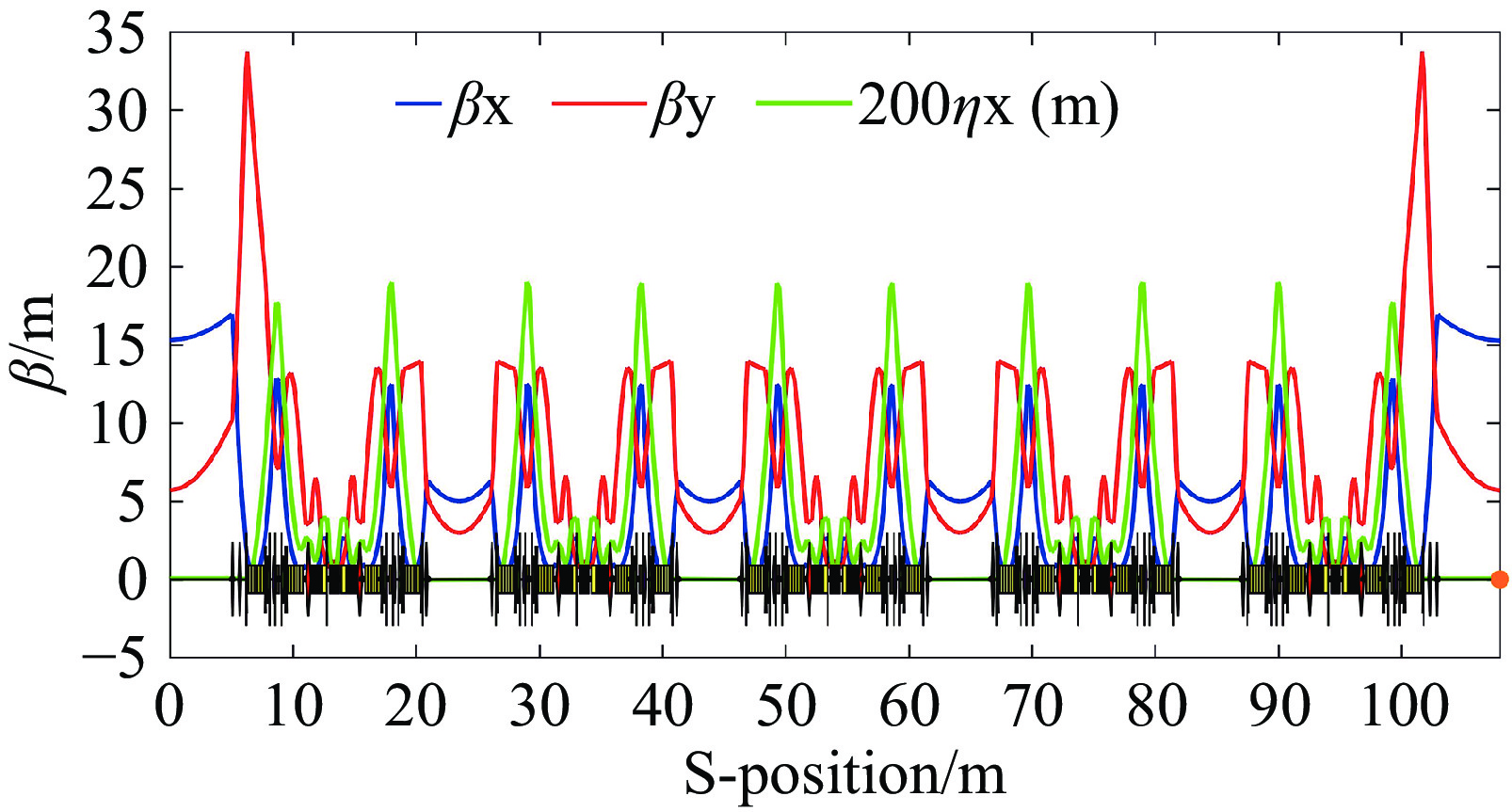
 下载:
下载:
